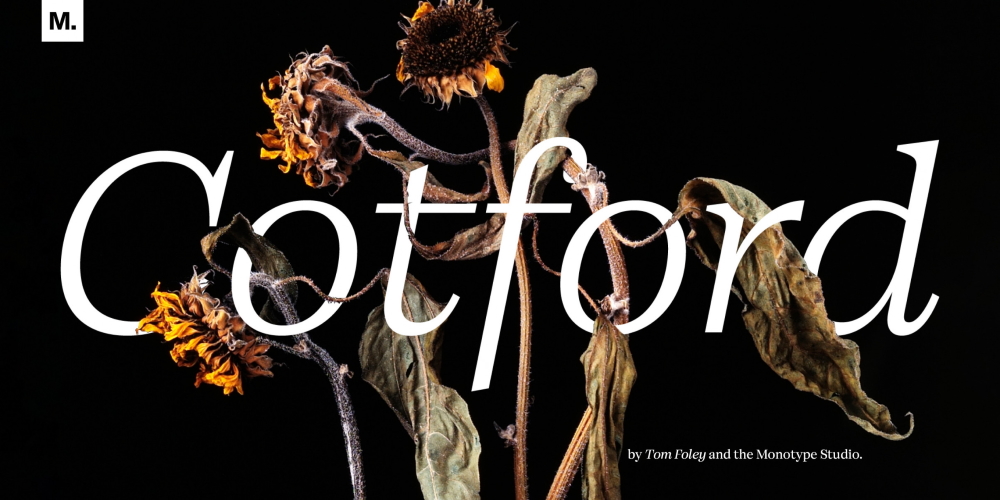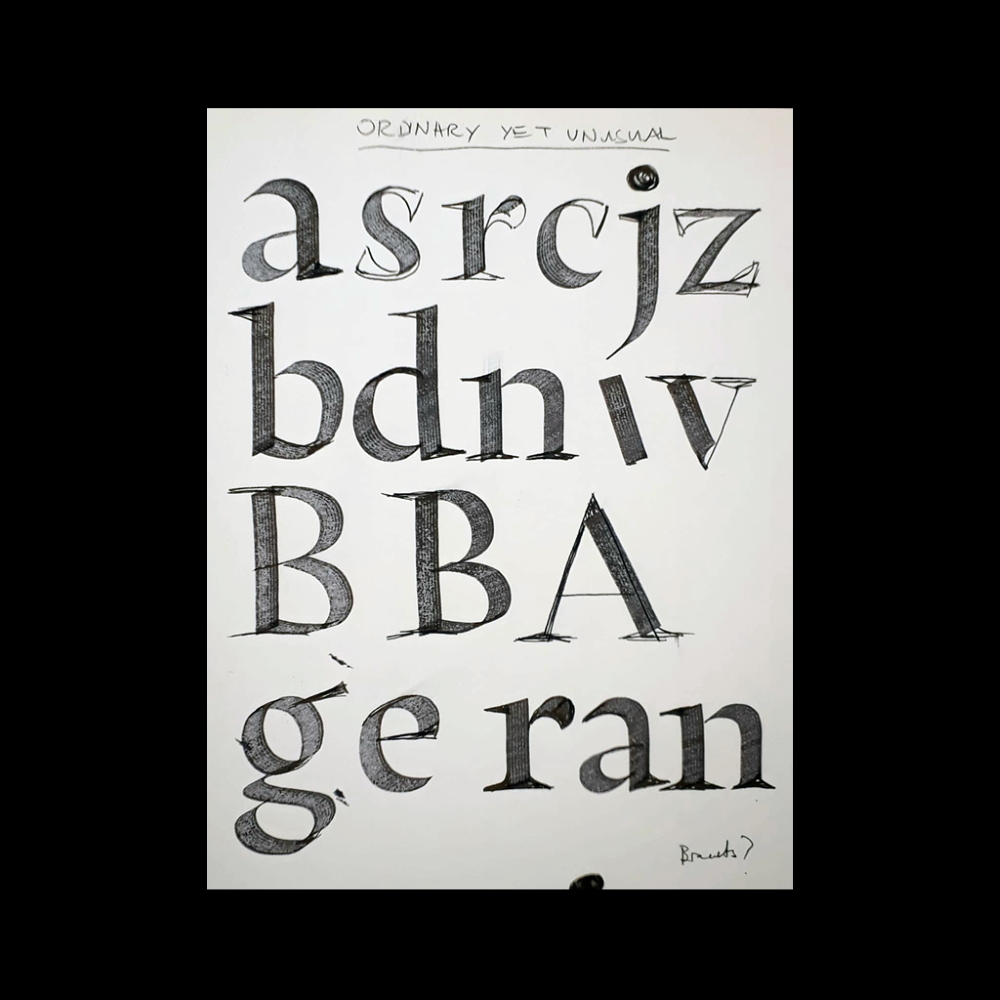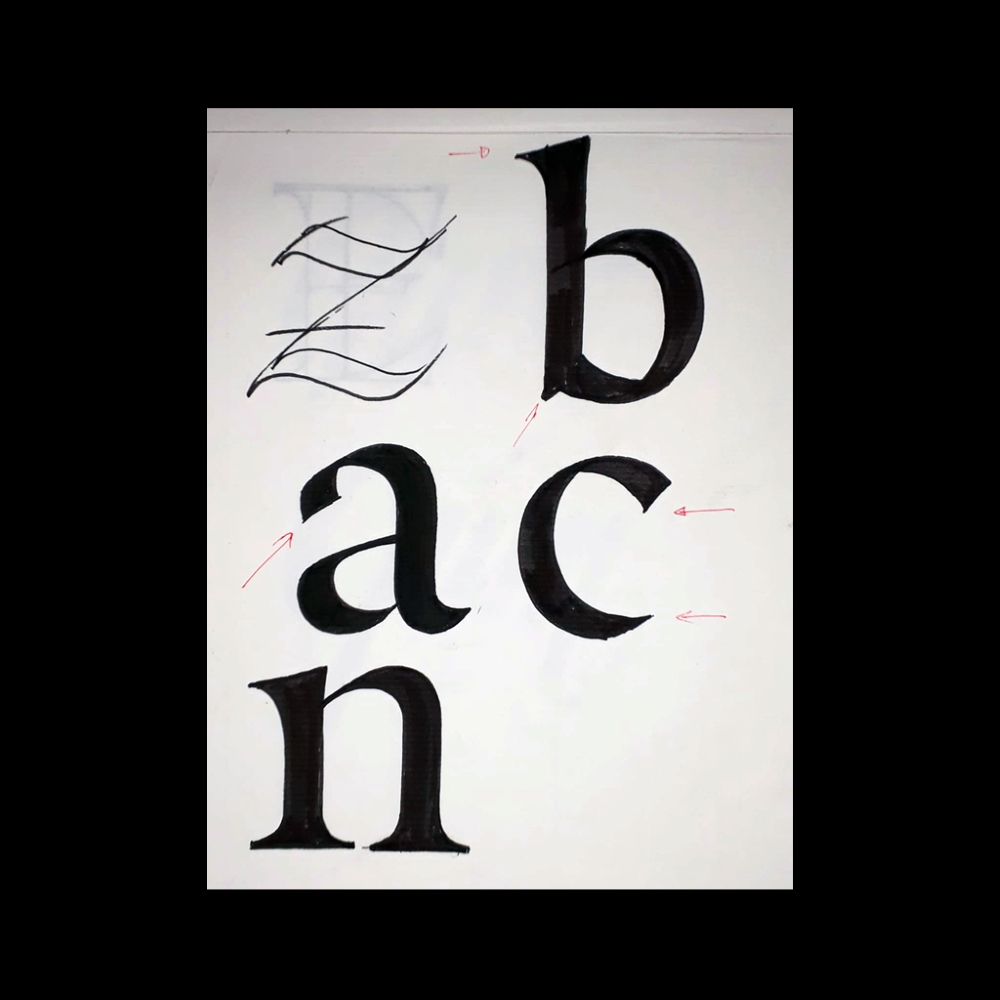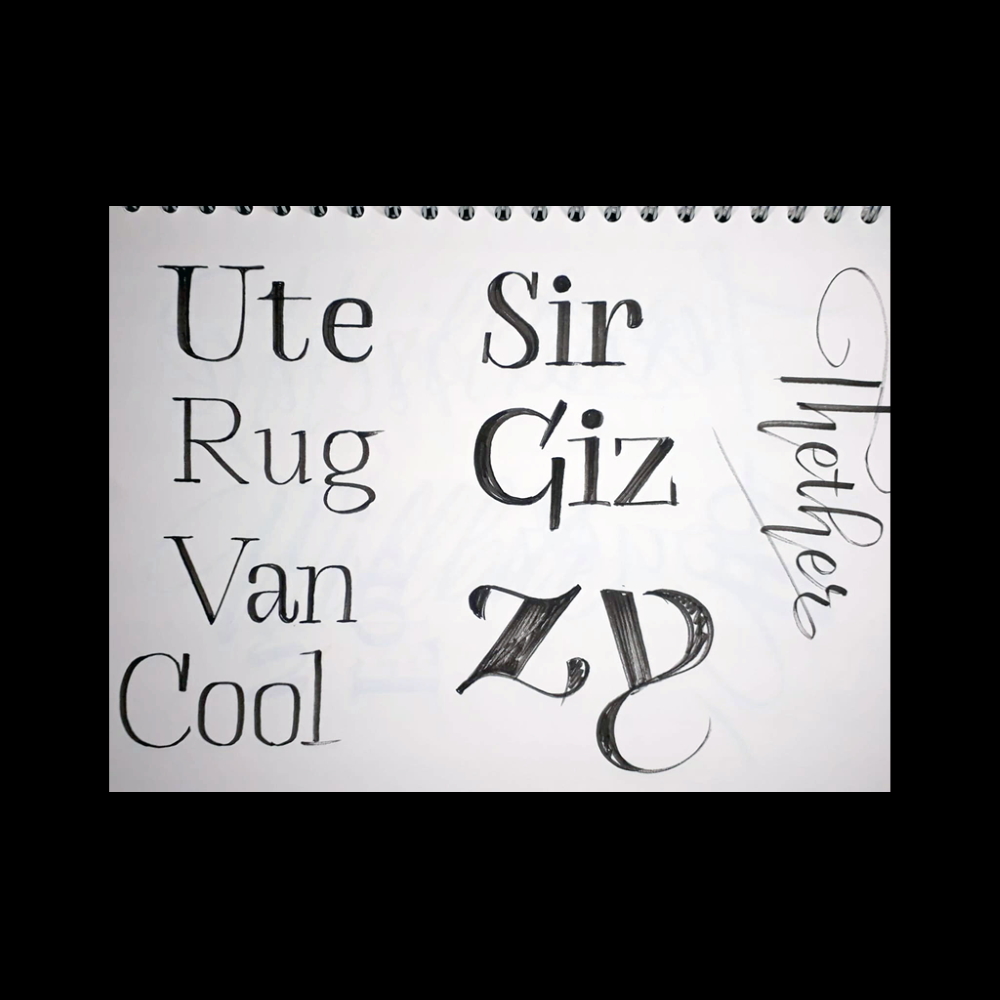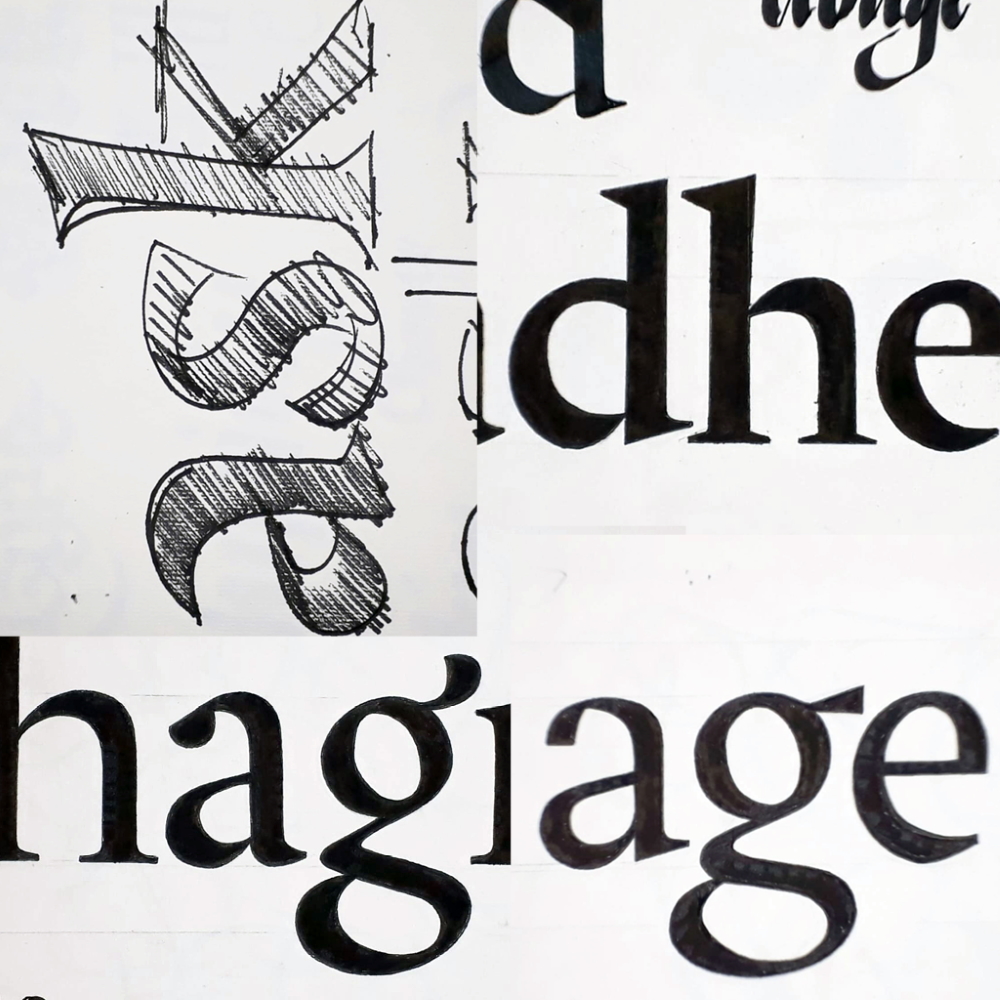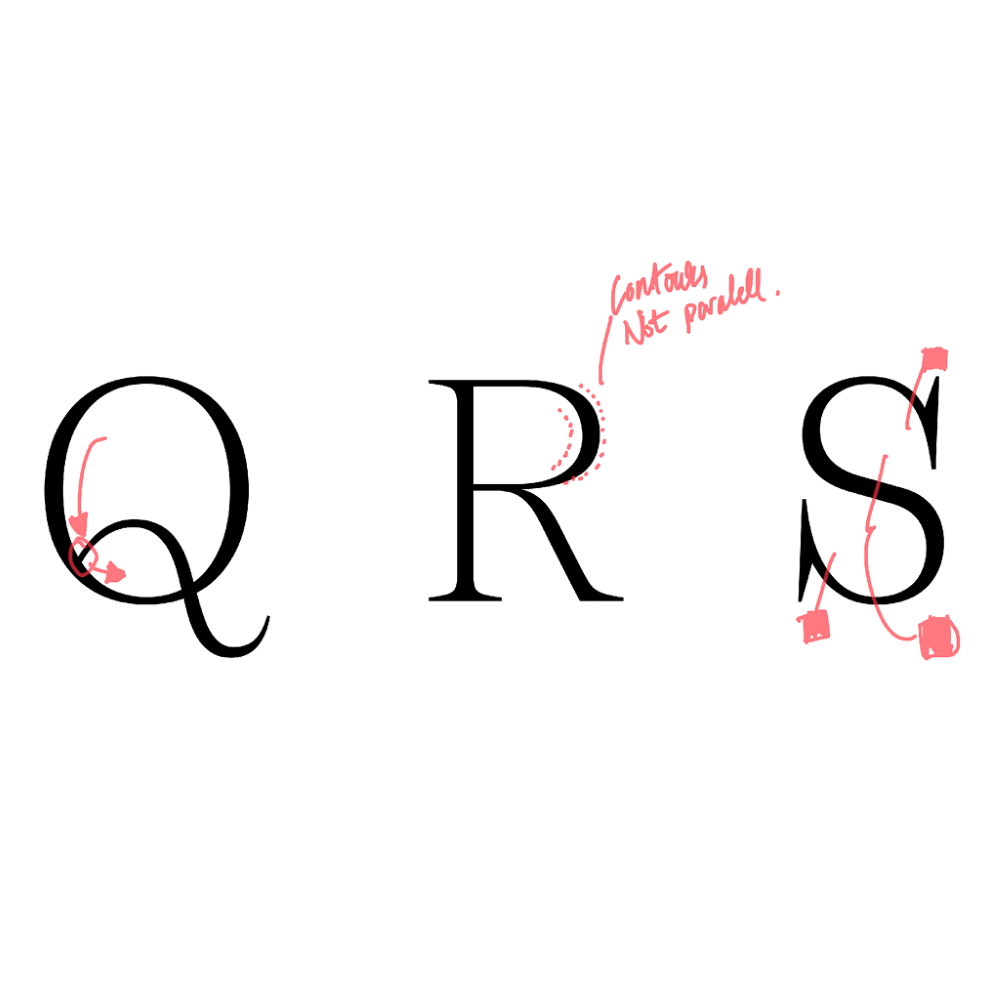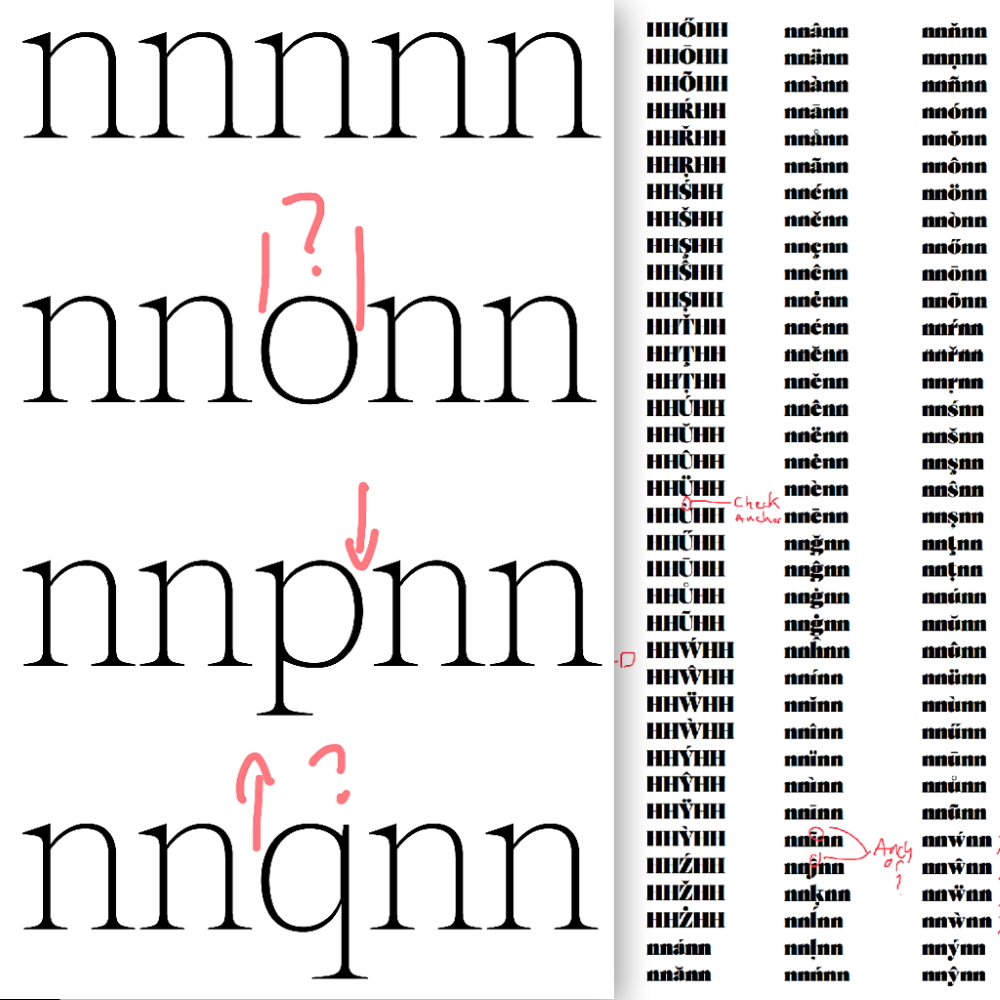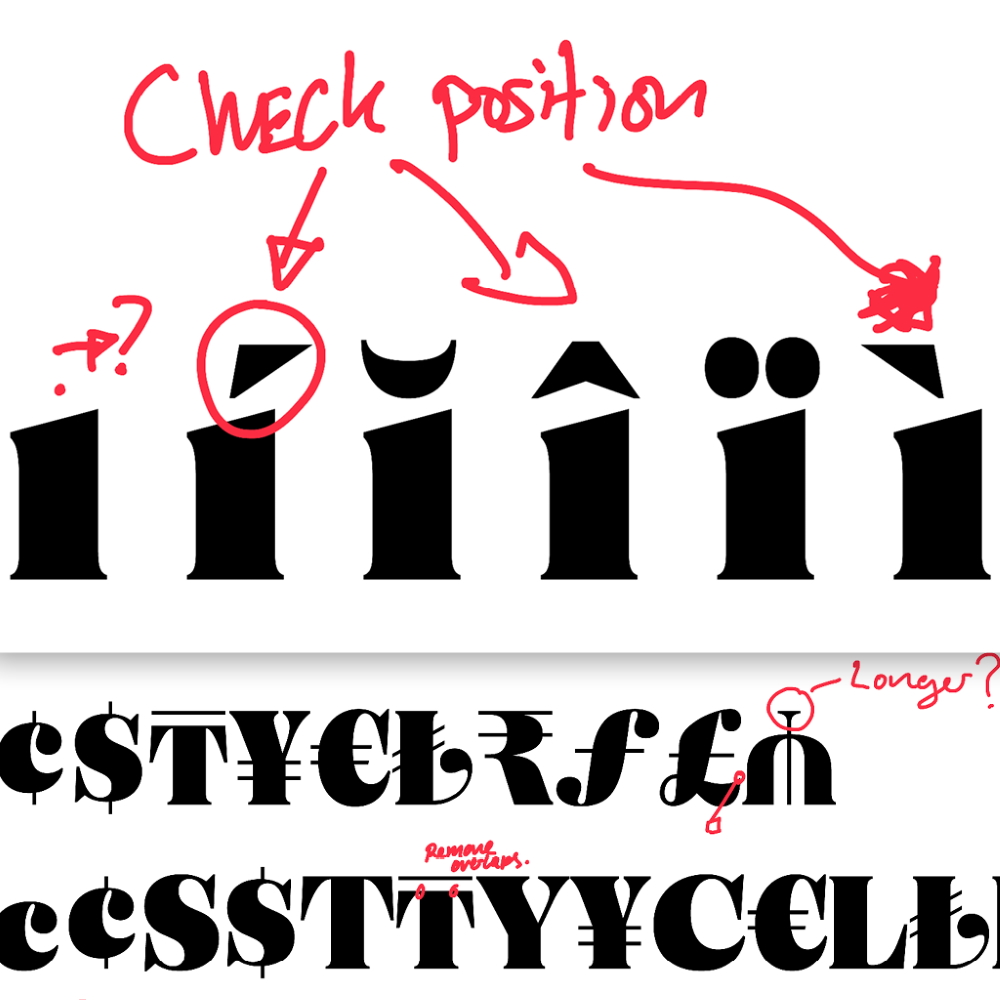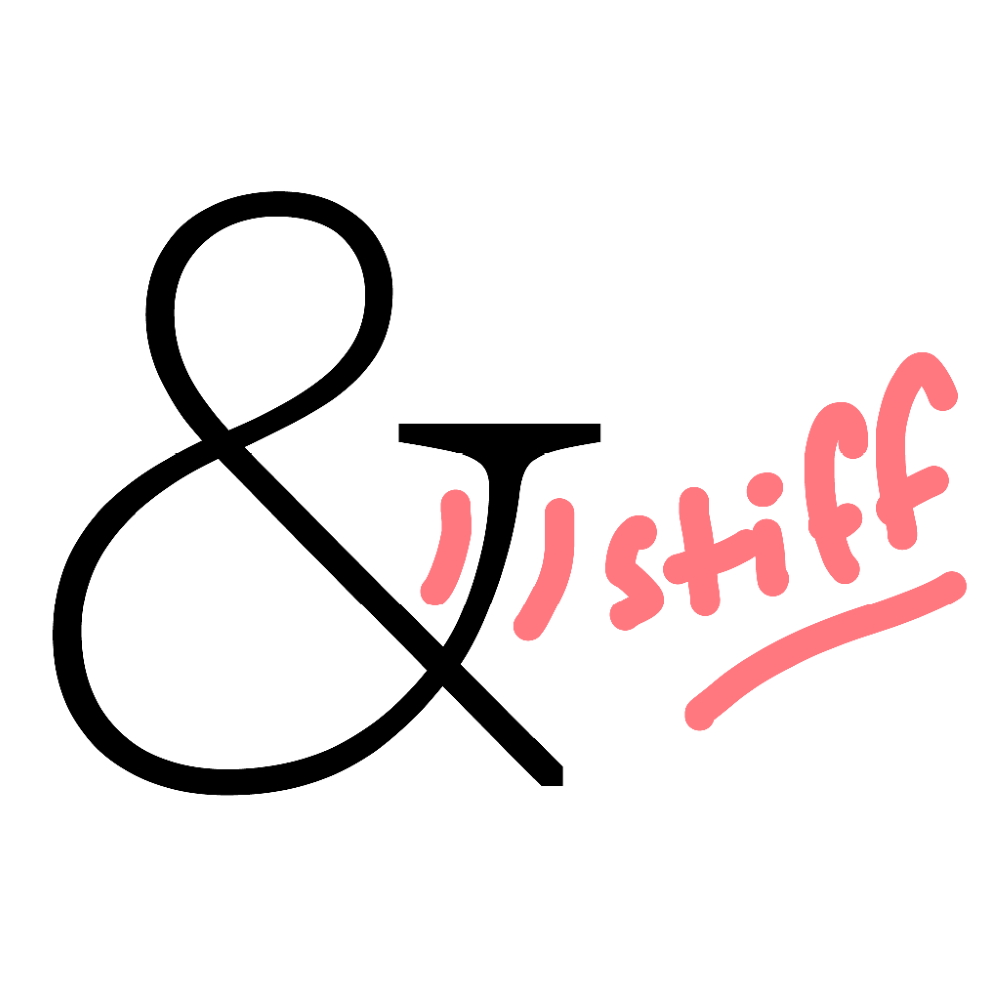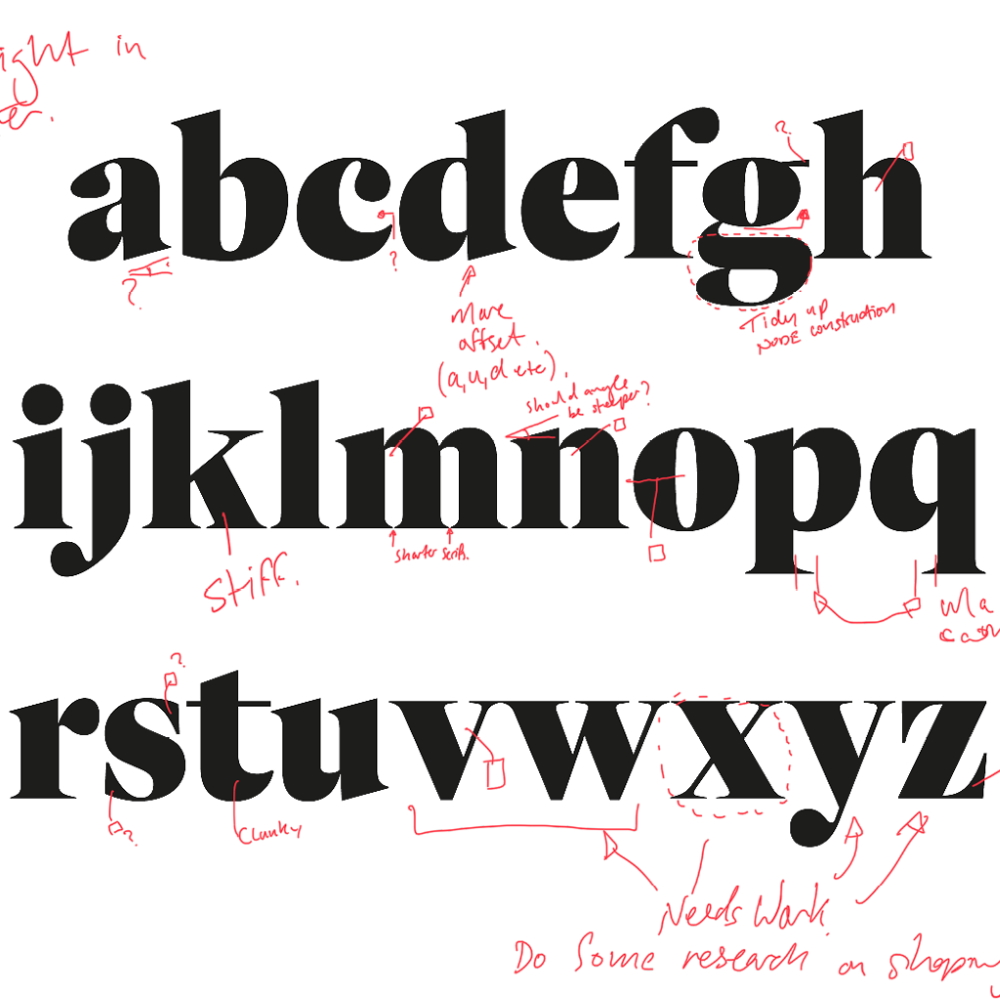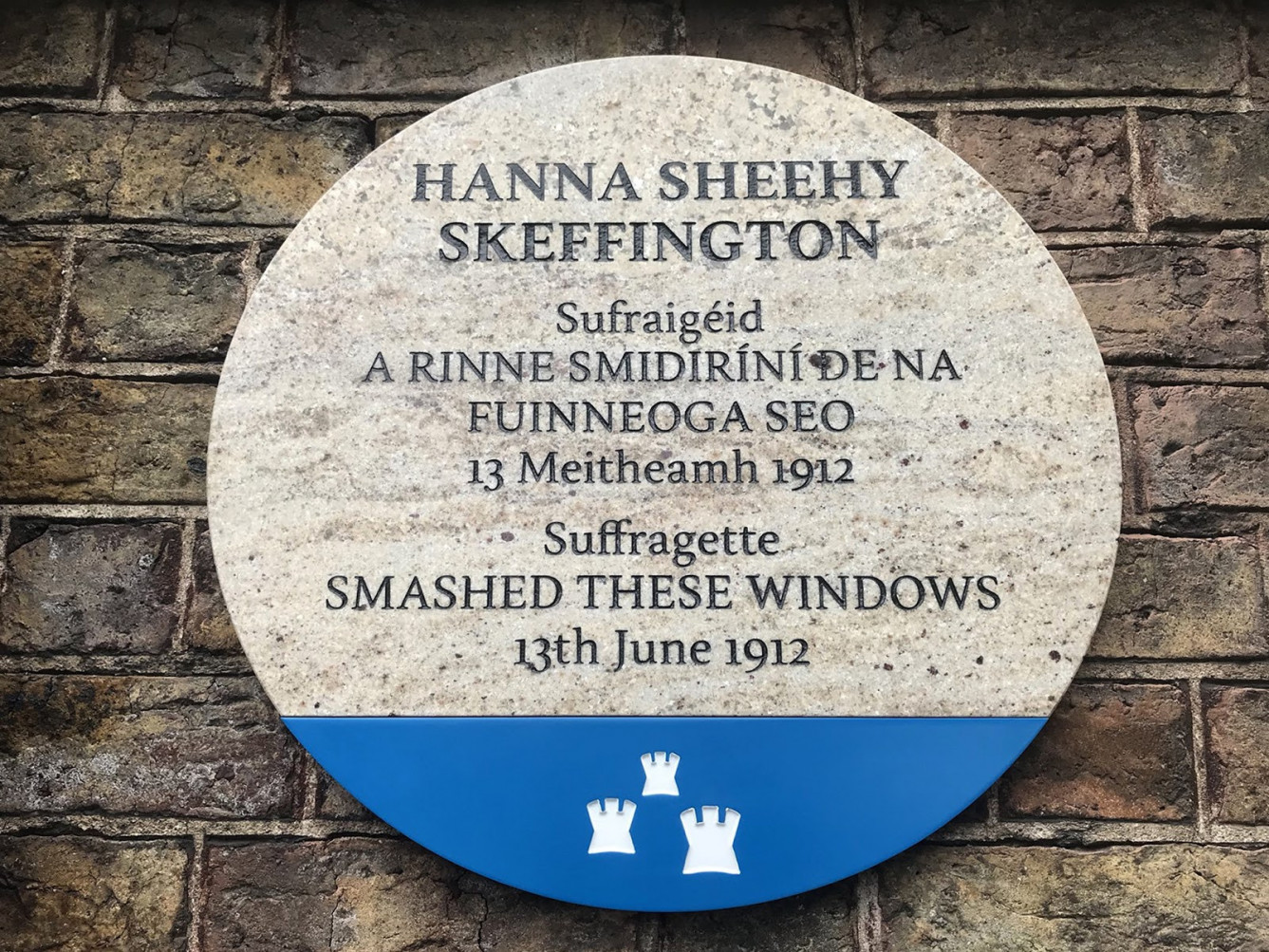Tom Foley
brand typographer
Ireland / GB
Typographic letters are an essential part of our daily life, but are ususally taken for granted, and rarely do we consider their origin. We live in a world of letters forming words – be it on displays, tv or road signs, in books, newspapers, shops, the net, typing them in the smartphone or computer, reading, writing et cetera. But the single characters that come in countless styles and sizes aren’t just simply there. They have to be created, each character carefully designed by a typeface designer. As such Typeface design is an art, because it „involves drawing each letterform using a consistent style“ (Wikipedia). Let’s dive deeper with an insider into the world of Monotype. This American company (founded in 1887) is the owner of some of the most popular typefaces in the world (Helvetica, Times New Roman, Gill Sans, Arial among many others).
Tom Foley
brand typographer
Ireland / GB
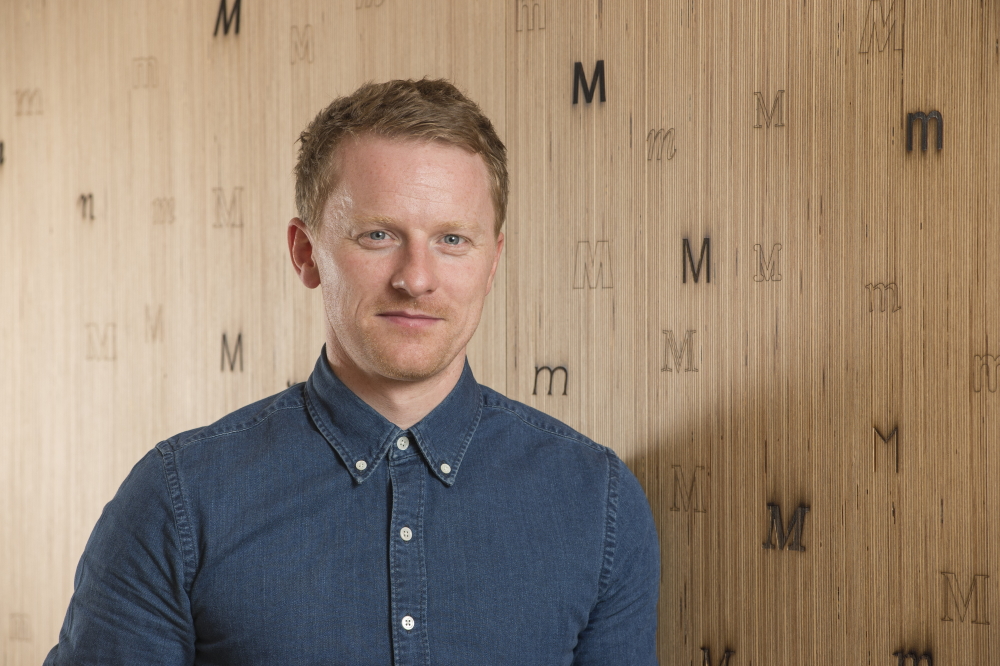
„Type is possibly one of the most difficult crafts to learn, because a good typeface is about detail, function, and almost being invisible.“ Tom Foley knows what he’s talking about being the Creative Type Director at Monotype, where he leads the studio design team in London. „In the current moment, it’s the need for type to be all things at once“, the Irishman says. „These days, type is asked to do an awful lot of heavy lifting for brand recognition and as a functional asset, so that’s a big challenge. There’s also a lot of new typefaces around, which makes it increasingly difficult to create innovative and interesting designs. That’s a good thing and a bad thing, though, because it pushes designers to try something new.“
He himself (from Wexford/Ireland) was literally born for this profession, although no one asked him to do it. Several relatives in his dad’s family had been stonemasons. „I’ve had an interest in type since an early age“, Mr.Foley admits. „My uncle was a sign painter and he did many of the signs around where I grew up, so I would always be reminded of that when I went for a walk. The notion of being slightly obsessed with lettering came quite early.“
„I don’t see myself as just a typeface designer. I do design typefaces, but not in a bubble. The main context for my work is branding… so maybe I am best described as a brand typographer. This is where my experience lies, and it's a practice that encompasses typeface design with design management and process management — along with a good deal of interaction with sales and marketing professionals, technologists and product designers. It’s a truly diverse profession and equal parts challenging and fulfilling.”
Foley obtained an MA in Communication Design Central from London’s ‚Central Saint Martins College of Art and Design‘ in 2009. Visiting lecturer on The MA Communication Design course at ‚Saint Martins‘ and the BA Visual Communications Course at ‚Bristol University of Art & Design‘.
This typeface designer who loves to do DIY home renovation in his free time, accentuates: „Type as a technology has never had to respond to so much change. Type has to work on so many new platforms and be accessible and useful to huge audiences across traditional and new mediums. All things together make it a very challenging and exciting industry to work in.“
Tom Foley is married and lives with his wife, a textile designer, in London.
Interview May 2022
The magic of type: detail, function and almost invisibility
INTUITION/IMAGINATION
“Intuition is the key to everything “, said internationally acclaimed filmmaker David Lynch („Twin Peaks"). „I think you could have an intellectual ability, but if you can sharpen your intuition, which they say is emotion and intellect joining together, then a knowingness occurs. “What sparks intuition for you, is it temporary or can it be engaged anytime?
For me, intuition is sparked by letterforms. I have always been intrigued and slightly obsessed with letters in all their various incarnations. Calligraphy, brand logos, handwriting styles, sign painted lettering, comic book mast heads, newspapers… Letterforms have always commanded my attention and sparked my creative intuition. Designing letters is a compulsive and instinctive act that brings me great joy and escapism.
How does intuition present itself – being a gut feeling or a suspicious impression?
With hesitation. I have a strong sense of intuition, but also a strong reflex to second guess myself. It’s like having the angle of intuition on one shoulder, and the devil of self-doubt on the other. This does come with advantages though; Keeping my ego in check, while making room to consider and absorb ideas and opinions from others.
Do you visualise something spontaneously in your mind’s eye - maybe in dreams?
Not really. I visualise through drawing and calligraphy. I can capture and hold a feeling or sense of something that I want to communicate, but its quite abstract. The act of writing and drawing letter forms allows me to bottle a feeling, and then distil it through a process of refinement.
Will any ideas be written down immediately and archived?
Yes, always. I keep a sketch book nearby at all times, and write down ideas that capture my attention.
What if there is a deadline, but no intuition? Does the first fuel the latter maybe?
This is a feature of my creative life. Most of my creative output is within the commercial constrains of branding and technology. I have developed techniques and methodologies to allow me to extract a creative solution within even the constrained circumstances. I’m so used to working in this way that it’s become instinct, and I actually find it much more difficult to create without the constraints of a deadline or client brief.
Are great ideas based on intuition or by almost endless trials and errors that result in constant developments up until the final result?
For me it’s a combination of both things, but also other factors. The context in which I create is important. To do great work I have to feel trusted and, be trusting of the people I collaborate with. Another factor is opportunity itself. The constraints of a brief, or even of a client’s expectations, has a major impact on the final result.
World-famous guitarist Carlos Santana said to me, when the “sky” opens and sends you a brainwave one has to grab that special spiritual moment for realising it before the clouds darken all again. What do you think about that?
I think that this idea of creativity is a truth for some people, but it doesn’t resonate with me. Creativity is a spectrum, and comes in many forms. Some people are endowed with the ability for spontaneous creative spark. Others have to work at idea for a long time, using craft and process to make something really work. Some have to the ability to create in a bubble, while others do their best work within the constraints of a brief or design problem. I belong to the latter. I am a designer who is best at solving clear problems or answering a commercial brief. All forms of creativity are equally valid in my opinion.
Does every idea exist immaterially already and just has to be put into effect, i.e. is creativity in its profound purpose basically about transferring dreams into reality?
All ideas exist in our minds, and even when something has been thought of, made, and seen but others, it still partially exists in the mind of its creator, and in the mind of the audience or consumer.
INSPIRATION
What inspires you and how do you stimulate this special form of imaginativeness?
I am inspired by many things: stories, technology, art, science, music… but the one thing that inspires me most is the beauty and purity of letter forms. Calligraphy, lettering, letter carving, typeface design… these things I am passionate about more than any other creative discipline. I can’t explain why, nor to I wish to.
Do calm and relaxation prove the most suitable or does pressure fire up creativity?
My work as a typeface designer is a way for me to step outside of life, it’s a form of escapism that is free from the need for calm, or from the daily pressures of life. I can immerse myself in design no matter how I am feeling.
How do you separate the good from the bad and which ideas are worthwhile to be explored further or whether one idea has the potential of being outstanding really?
It depends. On a commercial or client project ideas are validated or approved by a combination of input from peers, superiors, and from clients. On a personal project, it’s more about personal taste and instinct, but also about craft and quality. Typeface design as a discipline also has a lot of historical and contemporary reference to draw on and compare a new typeface design to. Another very important aspect about typography is that its application defines many attributes of a design. If a typeface is to be used at very large sizes, then certain attributes of contrast, proportion and detail will apply. Equally if a typeface is intended for use at 6 pixels in size on a smart phone screen, very different typograhic attributes are required. All this feeds into what makes a good or bad idea when it comes to typeface design.
What key characteristic does an idea need to be viable i.e. does it have to appeal to you personally or promise commercial potential/fulfil certain needs?
The characteristics of a viable idea are not fixed. For me it must solve a problem or fulfil a purpose, which again will vary from one context to the next. It’s quite east to identify a need or purpose in a commercial context, as there will be clear client need to solve for, as well as aesthetic and technical boundaries to work within. In the context of a personal project, identifying a need or purpose can be more difficult, as one must identify the need. A great typeface designer can also just create something new that resonates with other designers and becomes a success without any clear intention of use.
Does inspiration for you reveal itself in a kind of clear and complete vision so that you just have to capture the fantasy in a way that’s authentic to your creativity?
Unfortunately, no (I wish I had this ability), but I do know some typeface designers that have this ability. Inspiration doesn’t give me a complete vision. If I have an idea, I then need to work hard to make it come to life.
Do you sometimes revisit old(er) ideas (especially in tough times of need)?
Yes, I think revisiting old ideas is important because they contain a portal into whatever references, or inputs were happening at that time. I sketch most days, and make notes on my sketch’s, so I know what ideas, feelings, moods or references informed that sketch. So even if old ideas never become anything more that, looking back over them will give a glimpse into what was swirling around my head and my heart at that time.
How long do you ponder an idea before creatively working on it?
Not long. If I have an idea I usually sketch or write it down straight away. This helps the idea breath and frees up space in my head to let the idea grow.
Do you check what colleagues/competitors are up to/your role models contrive(d)?
Of course. Being aware of what other typeface designer are doing is vital, and for many reasons. It provides inspiration, it informs the quality of my own work, it gives commercial insights, but most importantly, it helps me build my own style and identity as a designer. Knowing what others are doing allows me to identify what is unique or ownable in my own design output.
CREATIVITY
Which time/place/environment suits your creative work process the best?
Mornings in a coffee shop with my headphones on listening to music.
Which path do you take from theory/idea to creation i.e. how do you start?
I take a very structured path. A clear and thorough process is a feature of my approach to typeface design (and for many other typeface designers too). The process has clear stages that allow for creative exploration, idea refinement, idea implementation, and technical testing. I have a clear and definable path from idea to creation.
What does your average creative day look like (early bird or night worker)?
I am an early bird. Typically, my creative day starts with a coffee, a quick sketch, looking at some inspiration, either in books or online, but after that it’s a free for all. My day-to-day work is as a Creative Type Director at Monotype, so anything can happen after 9am.
How important are self-doubt and criticism (by others) during such a process?
I think self-doubt and criticism are the negative ends of a spectrum, that do not help creativity. It’s important to be self-critical, and for others to provide constructive feedback, but criticism from others only leads to self-doubt, which leads to failure. I never criticise others and spend a lot my working life building the skills and confidence of my team mates so that they don’t suffer from self-doubt.
Is it better to be creative on your own, only trust your own instincts, or in a team?
I work well on my own or in team. Creating as a team requires real collaboration, which is about trust, communication and clear definition of roles and responsibilities. Creating on my own requires discipline, planning and stamina.
Does age/life experience help with creativity or is a younger mind more creative, ‘cos it’s fresh and untouched by experience? What about social/cultural heritage?
All of these things influence creativity. There is an energy and naivety in youth that can lead to innovation. But there is a stability and confidence in age that can also lead to creative innovation. The ideas I have now are very different to the ideas I had when I was 22, but they are no less relevant useful. They are just different.
Cultural and social background influences every aspect of someone, including creativity. For me, being working class and Irish has an influence, but so does all the TV I watched as a kid, the music I love, the friends I’ve made over the years, my family, my experiences. It’s all one big melting pot. What’s important is to not lose touch with one’s creativity, and to allow it to continually evolve and change as your life does.
What is your personal approach/motivation/concern regarding creative activity?
My approach to creativity is that it’s all I know and the only thing I was every good at.
My motivation as a creative is instinctive, meaning I do it instinctively.
My concern as a creative is to make things that have a purpose and provide value.
If you’d make a pie-chart: what is your satisfaction based upon - a) self-realisation/ personal compliance, b) artistic recognition or c) commercial success & fame?
Satisfaction is not something I aim for from my creative practice. I am more focused on improving and learning.
How does a creative find his/her own style/possibly unique way of expression?
By exploring new ideas and working hard to bring those ideas to life.
Is craftmanship important or should creatives be able to work 100% unloaded?
Craft is a vital component of creativity, and is something all creatives should develop, or at least seek to understand, in my opinion.
Can routine, experience and professionalism make up for lack of creativity?
No, unfortunately. But people with these traits are vital to creative industries and are often undervalued. Without these people most creative people would not succeed.
If problems occur during the creativity or one’s stuck, how can that be solved?
Take a break, do something different, find a way to rest your mind. Creativity will never leave you, it just needs a rest from time to time.
Are a never give up attitude and persistently hanging on necessities for creatives?
When starting out, yes. I also find that resilience and positivity are common qualities for creative people, which is something all creatives need at some point in their lives.
Which is better in the development process: speed and – if that’s possible - force creativity i.e. grasp the magic of the moment, or a slow, ripening process when it comes to implementation and elaboration?
It really depends. Some creatives need spontaneity, but even those require a strong understanding of the craft of their discipline. Others need time and process, like designing and developing a brand system or designing a building. Making a movie takes time and planning, but the performance of the actor can draw on spontaneity of the moment or chemistry with a co-star. As a typeface designer it’s a slower process by nature.
„Creativity is the ability to reorganise known factors so that they become novel and fresh. “Do you agree with British rock-manager Tony Stratton-Smith?
To an extent, this is one view on creativity.
Should a creative always remain true to him-/herself including taking risks & going against the flow or must one, for reasons of (commercial) survival, make concessions to the demands of the market, the wishes of clients and the audience’s expectations?
Again, it depends on many factors.
If one is seeking commercial success and fame, then making concessions of market demand is important. If one is creating for their own pleasure, without any commercial expectation, then they are free to take as many risks as they like.
How is innovation still possible if one has established a distinctive style?
By working in new mediums, learning new skills, or collaborating with new people.
Is it good to be ahead of one’s time even one hazards not being understood at all?
On a personal level, probably not. Being ahead of your time and not understood usually goes with a lack of recognition or income. But the struggle unrecognised artists go through can be a contributing factor to what drives their creativity and brilliance.
When does the time come to end the creative process, to be content and set the final result free - or is it work-in-progress with an endless possibility of improvement?
When the deadline arrives.
In case of failure or - worse - a creativity crisis how do you get out of such a hole?
I’ve always worked through failures by knuckling down and persevering. Failure is inevitable too, and it’s important to learn from failure, but also learn to let it go.
Did you ever deliver something that you considered mediocre, but was successful?
Yes, many times. It’s not uncommon for my own success metrics to differ from that of a client’s or audience’s.
SUCCESS
Why are some people successful and others not - despite the same talents?
Circumstance and luck. Nothing more.
Should/can one resist the temptation to recycle a ‘formula’ one’s successful with?
So long as it leads to good creative output, there is no need to change. But when things get tough it’s important to be open to change, so you can adapt.
Is it desirable to create the ultimate/timeless work, but doesn’t “top of the ladder” bring up the question of “what’s next?” i.e. isn’t such a personal peak “the end”?
I don’t aim for lofty ideas like timeless or ground breaking work. I produce what I feel is the best solution for any given project. After that, it’s out of my hands what other make of it. If my work has some long-term relevance, great, if not, that’s ok too.
MY FAVORITE WORK:
In 2021 I designed a typeface named ‘Cotford’. This was a big personal and creative achievement for me. It is the first typeface I designed completely outside of a client brief. This was a very challenging and enjoyable process, and allowed me to grow as a creative and designer.

